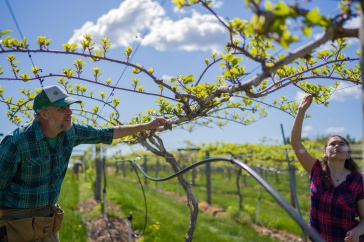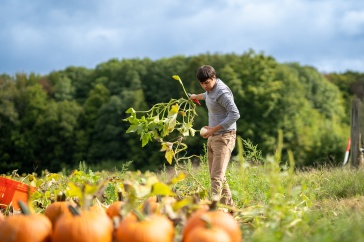Annual strawberry production systems in New Hampshire presented by Matt Kochka at the 2014 NH Farm & Forest Expo
Researchers at the NH Agricultural Experiment Station (NHAES) at the University of New Hampshire investigating a strawberry production system used throughout the nation’s leading strawberry producing regions believe the system – the annualized plasticulture system – holds economic promise for New Hampshire’s and New England’s strawberry producers.
“As researchers at the New Hampshire Agricultural Experiment Station, we are trying to help growers develop an answer to the question ‘is it worth it’ to look at this innovative system in New England? Is the investment going to be worth the yield?” says Matt Kochka, a UNH graduate student in plant biology who is supported by the NHAES.
“Our investment in this research reflects our conviction that the role of agricultural research programs in the public sector is to take risks that producers cannot afford to take, in an effort to identify practices that growers can adopt, confident in their potential to benefit their individual production systems,” Kochka says.
College of Life Sciences and Agriculture Dean and NHAES Director Jon Wraith strongly agrees and notes that the research and outreach undertaken by the NH Agricultural Experiment Station is responsible for many management practices, technologies and varieties used by producers in New Hampshire and New England. This includes a focus on improved nutrition, efficient resource use, better marketability, and economic viability.
In response to a survey of growers’ needs, Kochka has been working with Iago Hale, assistant professor of specialty crop improvement, to conduct small-scale trials comparing the economics of the standard matted-row production system with those of an annual plasticulture system at Kingman Farm, one of five NHAES facilities at UNH.
In New England, strawberry producers traditionally have used the conventional perennial matted-row production system, which takes a year to establish strawberry plants before yielding two to three years of summer harvests. In contrast, the annualized plasticulture system, which is the dominant system used by major strawberry producers, including those in California and Florida, produces a crop the same year it is planted. Depending on the strawberry variety used, both production systems have the potential to provide two annual harvests, one in summer and one in fall, an additional option the researchers are evaluating.
While plasticulture systems are more expensive to establish—approximately three times the initial investment as matted-row systems—their annual nature facilitates management of soil-borne disease via rotation. Their yields are also potentially higher, which may allow growers to quickly recoup that front-end cost, according to Kochka. Furthermore, in between summer harvest and fall planting, an annualized strawberry producer can grow another crop to supplement their income.
“This gross income could be $40,000 an acre or more. It could be anything that grows and comes to maturity between planting in May or June and harvesting in August. That is a wide range of crops and a huge potential income,” Kochka says.
Plasticulture also appeals to organic producers trying to meet an increasing consumer demand for berries free of synthetic pesticides because there is more flexibility to move crops every year.
Kochka is in the process of conducting larger-scale comparative field trials—along with an economic analysis—by growing two day-neutral and two June-bearing strawberries with the plasticulture system at the NHAES’ Kingman Farm. As is typical with matted row, producers might get a good crop the first and second harvest years but later have problems with pests and pathogens that build up in the soil in successive years. Therefore, Kochka will be examining these pests and pathogens as well as looking at the genetics in wheat, a model rotation crop, that suppress nematodes.
Once Kochka’s research is completed later this year, he plans to develop a strawberry production booklet, a budgeting tool consisting of an enterprise budget calculator, a fact sheet, and a guide to growing strawberries using the plasticulture system for New Hampshire and New England strawberry growers.
Kochka recently presented this research during an NHAES education session at the 2014 New Hampshire Farm and Forest Expo. His presentation is available here. View all of the NHAES education research session videos from the 2014 New Hampshire Farm and Forest Expo.
Founded in 1877, the New Hampshire Agricultural Experiment Station at the UNH College of Life Sciences and Agriculture is an elemental component of New Hampshire's land grant university heritage and mission, since before UNH was located in Durham. We steward federal and state funding to provide unbiased and objective research concerning diverse aspects of sustainable agriculture, aquaculture, forest management, and related wildlife and natural resources. We maintain the Woodman and Kingman agronomy and horticultural farms, the Macfarlane Greenhouses, the Fairchild Dairy Teaching and Research Center, and the Organic Dairy Research Farm. Additional properties also provide forage, forests and woodlands in direct support to research, teaching, and outreach.
Originally published by:
UNH Today
-
Written By:
Lori Tyler Gula, PhD | NH Agricultural Experiment Station | lori.gula@unh.edu | 603-862-1452



















































